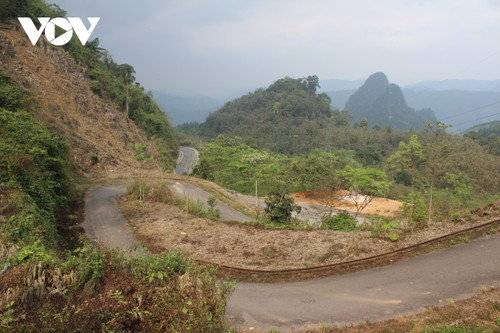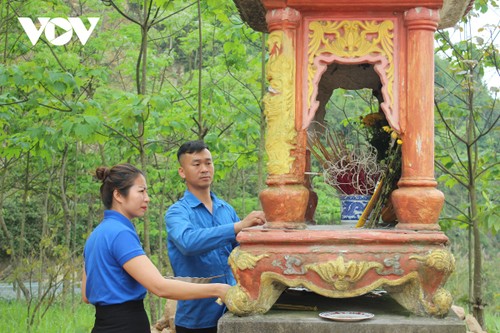 A section of the Lung Lo pass in Van Chan district, Yen Bai province (Photo: VOV) A section of the Lung Lo pass in Van Chan district, Yen Bai province (Photo: VOV) |
Lung Lo pass is in Thuong Bang La commune, Van Chan district, Yen Bai province. For the Dien Bien Phu campaign, the Party Central Committee opened route 13A from Ben Hien in Tuyen Quang province, past Ben Au Lau to Lung Lo pass to connect with Road 41 (now Highway 6) at the Co Noi T-junction in Son La province.
The trail stretched 120 kilometers over high mountains and across three big rivers – the Chay, the Red, and the Da. Lung Lo pass, one of the most treacherous sections, had a steep mountain on one side and a deep abyss on the other.
80-year-old Ha Van Ho of Thuong Bang La commune, Yen Bai province, recalled that in early 1953 many sappers and workers slept at his parents’ house while they were building Road 13.
“The people of Thuong Bang La commune and more than 300 people from other places helped clear the road. They were divided into three units called T100. Each unit had its own mission. The guard unit was in charge of alerting people of approaching enemy aircraft so they could take cover in the shelters. One unit rescued and repaired vehicles which became stuck in the mud. And there was one medical unit that also participated in transporting weapons,” said Ho.
More than 124,000 sappers and civil workers used millions of bamboo plants and trees contributed by local people to build the route through Lung Lo pass in about 200 days. Tens of thousands of trucks, carts, and pack-bikes carried weapons and food to the battlefield.
To obstruct the supply route to Dien Bien Phu, the French army dropped about 12,000 tons of bombs on Lung Lo pass. Some days they dropped as many as 200 bombs. During the campaign, 16 to 18 enemy planes bombed the area five to six times a day.
But tens of thousands of people bravely risked their lives under bombs and bullets to keep the road clear for undisrupted transportation. Dozen thousands of tons of military equipment, weapons, and food were stockpiled at Thuong Bang La and transported across the pass to the battlefield.
Ha Van Ho said: “In Tham village the road crossed a large swampy area where local people could not grow rice and buffaloes could not walk through. The local people contributed wood to pave the way. They arranged wooden logs horizontally and vertically and packed soil over them to make a foundation. Bombs were dropped from Da village to the top of Lung Lo pass almost every day.”
 Members of Thuong Bang La commune's Youth Union clean the memorial site on Lung Lo pass. (Photo: VOV) Members of Thuong Bang La commune's Youth Union clean the memorial site on Lung Lo pass. (Photo: VOV) |
On April 27, 2011, Lung Lo pass was recognized as a National Historical Site by the Ministry of Culture, Sports, and Tourism. At the top of the pass stands a memorial stele, where people often stop to burn incense for the people who sacrificed their lives for national independence.
Teacher Le Thi Nhu Quynh of Thuong Bang La kindergarten, said: “Every year on December 22, the school teachers come here to pay tribute to the fallen and honor our revolutionary tradition and this legendary trail. On holidays we come here to clean the memorial site and surrounding area.”
Lung Lo pass has been improved with new sections of gentler curves and slopes. The pass remains an important trade route between Thuong Bang La commune and other places in the northwestern region.